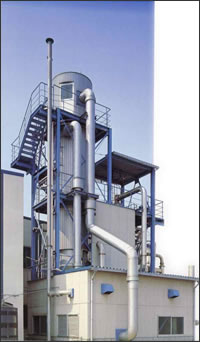Coulter spray dryer

The Coulter spray dryer was developed by Dr. Coulter at the University of Minnesota in the U.S., and has many excellent features. It is a system that dries the sprayed liquid (solid component) with hot gas in the drying chamber. (Also effective as a granulator.) Open type and Closed type are available.
- Highly-effective operation with high temperature and high pressure spray method.
- Compact design and small installation space.
- Installable at a clean room.
- Validated as a GMP-compatible Pharmaceutical manufacturing facility.
- No contamination of burnt powders due to no adhering.
- Possible long term operation.
- Low running cost.
- High thermal efficiency due to two-phase drying method.
- High operation rate due to no breakdown.
- High collection efficiency of the product due to blowdown.
- High viscosity solutions dryable by high concentration pressure spray method.
- Automatic control.
- Automatic cleaning system installable (option). CIP cleaning system installable (option).
Open type
After spray drying process, a scrubber makes the dried air cool, clean and release into the air.
Closed type
Closed type dryer circulates the dried air inside instead of releasing it into the air.
Closed type is applicable to the following raw solution;
- Organic solvents.
- Solvent emitting odorous gas in drying process.
- Solvent easy to be oxidized.
- Substances of dust explosive nature, flammable nature and inflammable nature. An organic solvent is recovered in condenser.
Circulation of inert gas or nitrogen surely avoid a risk of explosions.
Achievement examples by our test machines.
[Dairy products]
Whole milk, skim milk, whey, casein, cream, milk cocoa, and cheese whey.
[Foods]
Starch, onions, soybean protein, garlic, gluten, soybean milk, yeast, enzymes, instant coffee, tea, soy sauce, caramel, various seasonings, dextrin, powder candy, cyclodextrin, bean jam, food coloring, and gelatin.
[Pharmaceutical]
Culture medium, vitamins, amino acids, blood, blood plasma, and crude pharmaceutical.
[Inorganic materials]
Potter's clay, kaolin, alumina, titanium oxides, salt, niobium hydroxide sodium silicate, calcium phosphate, sodium sulfate, calcium carbonate and aluminum sulfate.
[Organic materials]
Stearic acid, chlorinated rubber, malic acid, acrylic acid, sodium formate, stearate, polyvinyl alcohol, and polyacrylic acid gel polymer flocculant.
[Others]
Agricultural chemicals, detergents, dyes, and latex.

